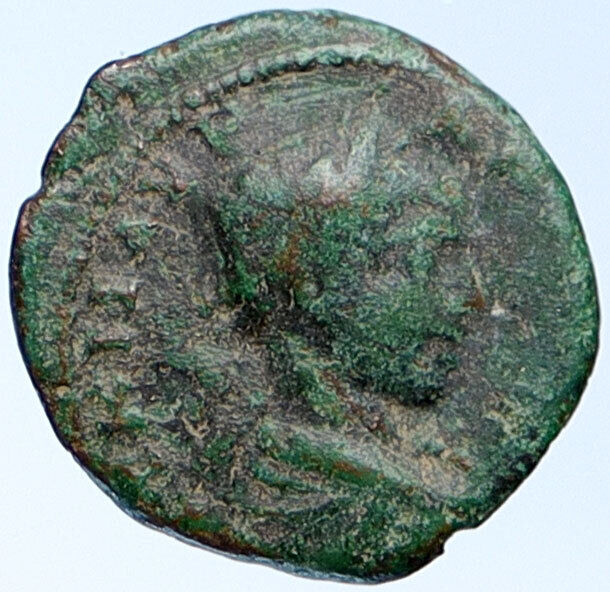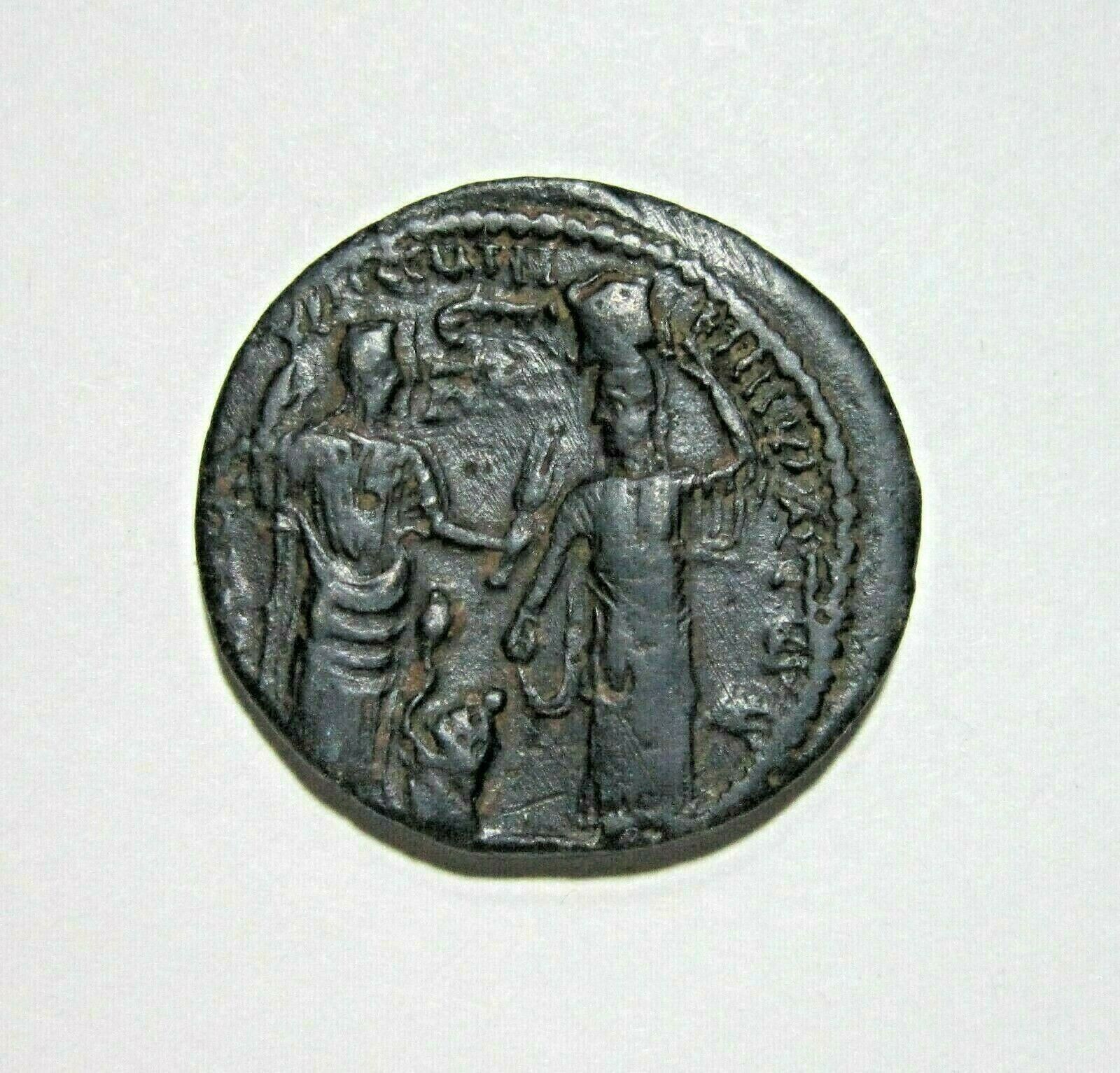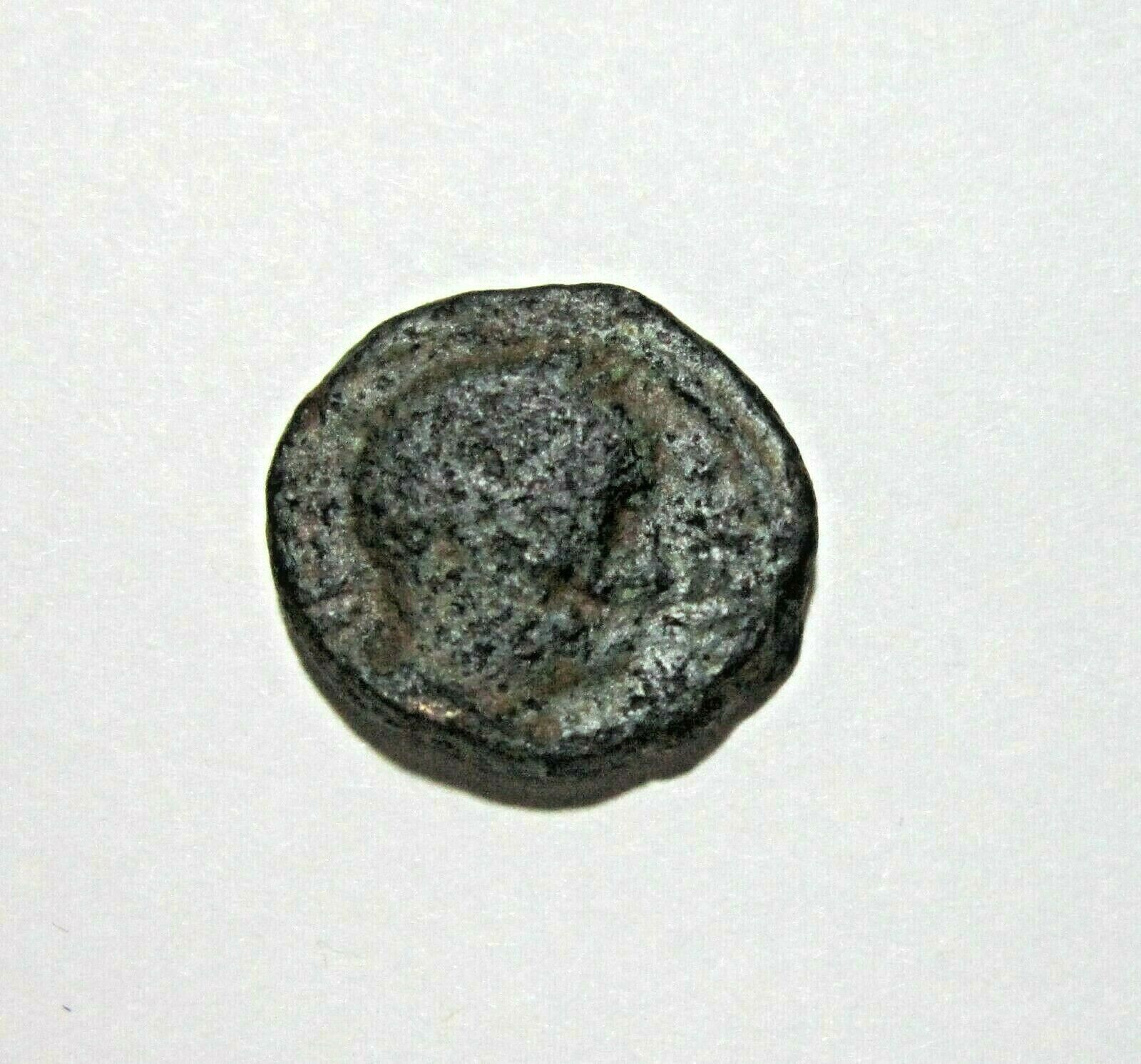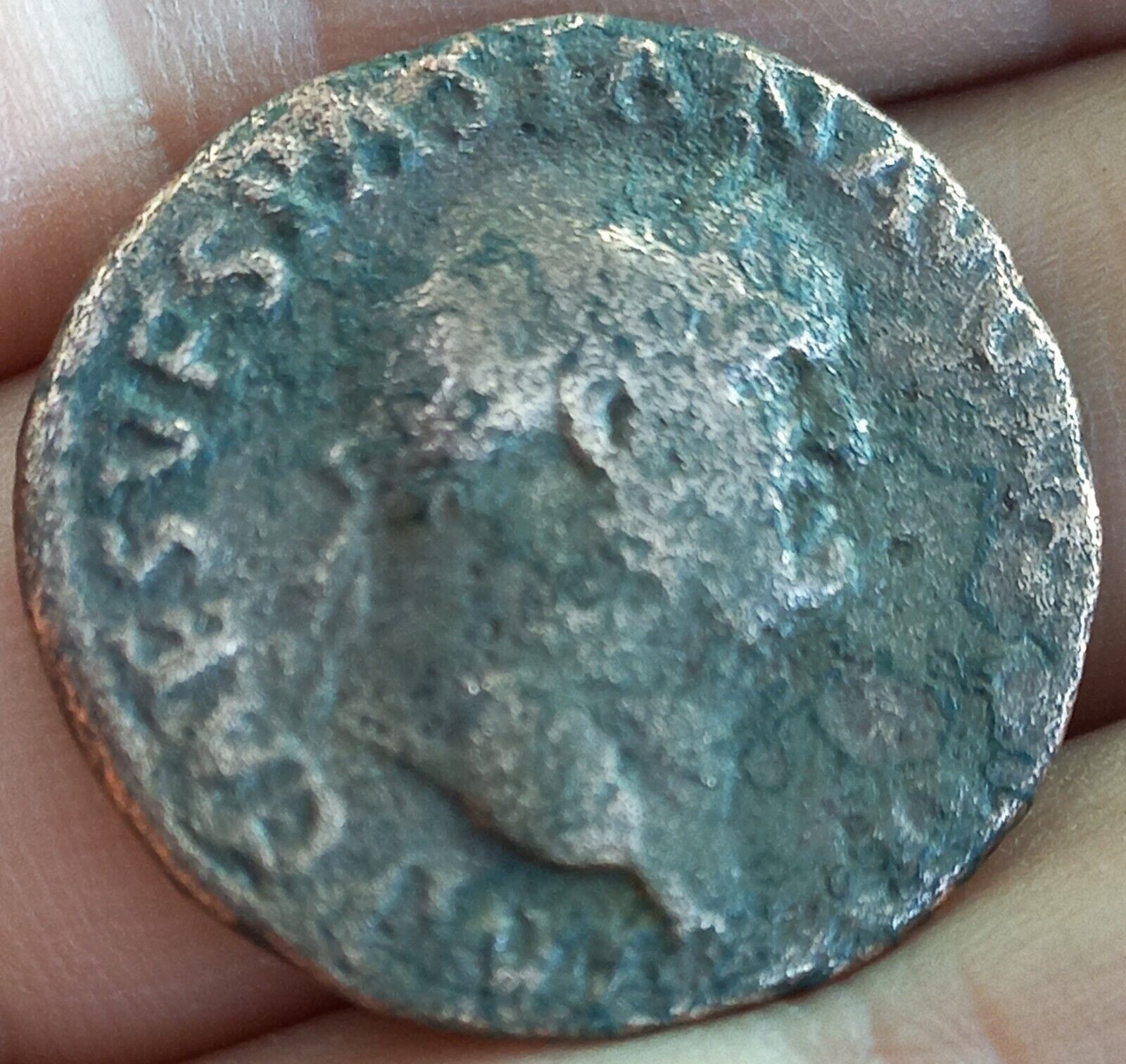-40%
ELAGABALUS Genuine Ancient Nicopolis ad istrum Roman Coin NAMEAN LION i115325
$ 31.04
- Description
- Size Guide
Description
Item:i115325
Authentic Ancient Coin of:
Elagabalus
-
Roman Emperor
: 218-222 A.D.
Bronze 16mm (2.42 grams) of
Nicopolis ad Istrum
in Moesia Inferior
AVT K M AVP ANTΩNINOC, Laureate, draped and cuirassed bust right.
ΝΙΚΟΠΟΛΙΤΩΝ ΠΡΟС ΙСT, Nemean Lion (the astrological zodiac sign of Leo and the constellation) standing right.
You are bidding on the exact item pictured, provided with a Certificate of Authenticity and Lifetime Guarantee of Authenticity.
The
Nemean lion
(Latin:
Leo Nemeaeus
) was a vicious monster in Greek mythology that lived at Nemea. It was eventually killed by Heracles. It could not be killed with mortals' weapons because its golden fur was impervious to attack. Its claws were sharper than mortals' swords and could cut through any armor.
Today, lions are not part of the Greek fauna (or the fauna of Europe). However, according to Herodotus, lion populations were extant in Ancient Greece, until around 100 BC when they became extinct.
The lion is usually considered to have been the offspring of Typhon (or Orthrus) and Echidna; it is also said to have fallen from the moon as the offspring of Zeus and Selene, or alternatively born of the Chimera. The Nemean lion was sent to Nemea in the Peloponnesus to terrorize the city.
Leo
is one of the constellations of the zodiac, lying between Cancer the crab to the west and Virgo the maiden to the east. Its name is Latin for lion, and to the ancient Greeks represented the Nemean Lion killed by the mythical Greek hero Heracles (known to the ancient Romans as Hercules) as one of his twelve labors. Its symbol is
(Unicode ♌). One of the 48 constellations described by the 2nd-century astronomer Ptolemy, Leo remains one of the 88 modern constellations today, and one of the most easily recognizable due to its many bright stars and a distinctive shape that is reminiscent of the crouching lion it depicts. The lion's mane and shoulders also form an asterism known as "The Sickle," which to modern observers may resemble a backwards "question mark."
The first of Heracles' twelve labours, set by King Eurystheus (his cousin) was to slay the Nemean lion.
According to one version of the myth, the Nemean lion took women as hostages to its lair in a cave near Nemea, luring warriors from nearby towns to save the damsel in distress. After entering the cave, the warrior would see a woman (usually feigning injury) and rush to her side. Once he was close, the woman would turn into a lion and kill the warrior, devouring his remains and giving the bones to Hades.
Heracles wandered the area until he came to the town of Cleonae. There he met a boy who said that if Heracles slew the Nemean lion and returned alive within 30 days, the town would sacrifice a lion to Zeus; but if he did not return within 30 days or he died, the boy would sacrifice himself to Zeus. Another version claims that he met Molorchos, a shepherd who had lost his son to the lion, saying that if he came back within 30 days, a ram would be sacrificed to Zeus. If he did not return within 30 days, it would be sacrificed to the dead Heracles as a mourning offering.
While searching for the lion, Heracles fetched some arrows to use against it, not knowing that its golden fur was impenetrable; when he found the lion and shot at it with his bow, he discovered the fur's protective property when the arrow bounced harmlessly off the creature's thigh. After some time, Heracles made the lion return to his cave. The cave had two entrances, one of which Heracles blocked; he then entered the other. In those dark and close quarters, Heracles stunned the beast with his club and, using his immense strength, strangled it to death. During the fight the lion bit off one of his fingers. Others say that he shot arrows at it, eventually shooting it in the unarmoured mouth.
After slaying the lion, he tried to skin it with a knife from his belt, but failed. He then tried sharpening the knife with a stone and even tried with the stone itself. Finally, Athena, noticing the hero's plight, told Heracles to use one of the lion's own claws to skin the pelt.
When he returned on the thirtieth day carrying the carcass of the lion on his shoulders, King Eurystheus was amazed and terrified. Eurystheus forbade him ever again to enter the city; in future he was to display the fruits of his labours outside the city gates. Eurystheus warned him that the tasks set for him would become increasingly difficult. He then sent Heracles off to complete his next quest, which was to destroy the Lernaean hydra.
The Nemean lion's coat was impervious to the elements and all but the most powerful weapons. Others say that Heracles' armour was, in fact, the hide of the lion of Cithaeron.
According to some authors, Heracles was helped in this labour by an Earth-born serpent, which followed him to Thebes and settled down in Aulis. It was later identified as the water snake which devoured the sparrows and was turned into stone in the prophecy about the Trojan War.
Nicopolis ad Istrum
was a Roman and Early Byzantine town founded by Emperor Trajan around 101-106, at the junction of the Iatrus (Yantra) and the Rositsa rivers, in memory of his victory over the Dacians. Its ruins are located at the village of Nikyup, 20 km north of Veliko Tarnovo in northern Bulgaria. The town reached its apogee during the reigns of Trajan, Hadrian, the Antonines and the Severan dynasty.
The classical town was planned according to the orthogonal system. The network of streets, the forum surrounded by an Ionic colonnade and many buildings, a two-nave room later turned into a basilica and other public buildings have been uncovered. The rich architectures and sculptures show a similarity with those of the ancient towns in Asia Minor. Nicopolis ad Istrum had issued coins, bearing images of its own public buildings.
In 447 AD, the town was destroyed by Attila's Huns. Perhaps it was already abandoned before the early 400s. In the 6th century, it was rebuilt as a powerful fortress enclosing little more than military buildings and churches, following a very common trend for the cities of that century in the Danube area.The largest area of the extensive ruins (21.55 hectares) of the classical Nicopolis was not reoccupied since the fort covered only one fourth of it (5.75 hectares), in the southeastern corner. The town became an episcopal centre during the early Byzantine period. It was finally destroyed by the Avar invasions at the end of the 6th century. A Bulgarian medieval settlement arose upon its ruins later (10th-14th century).
Nicopolis ad Istrum can be said to have been the birthplace of Germanic literary tradition. In the 4th century, the Gothic bishop, missionary and translator Ulfilas (Wulfila) obtained permission from Emperor Constantius II to immigrate with his flock of converts to Moesia and settle near Nicopolis ad Istrum in 347-8. There, he invented the Gothic alphabet and translated the Bible from Greek to Gothic.
Elagabalus
-
Emperor
: 218-222 A.D.
Son of
Julia Soaemias
| Husband of
Julia Paula
,
Aquilia Severa
and
Annia Faustina
| Grandson of
Julia Maesa
| Nephew of
Julia Mamaea
| Cousin of
Severus Alexander
| Second-cousin of
Geta
and
Caracalla
(Supposedly a natural son of Caracalla) | Great-nephew of
Septimius Severus
and
Julia Domna
|
Elagabalus
(Marcus Aurelius Antoninus Augustus, ca. 203 - 11 March 222), also known as
Heliogabalus
, was Roman Emperor from 218 to 222. A member of the Severan Dynasty, he was Syrian on his mother's side, the son of Julia Soaemias and Sextus Varius Marcellus. In his early youth he served as a priest of the god Elagabal (in Latin,
Elagabalus
) in the hometown of his mother's family, Emesa. As a private citizen, he was probably named Sextus Varius Avitus Bassianus. Upon becoming emperor he took the name Marcus Aurelius Antoninus Augustus. He was called Elagabalus only after his death.
In 217, the emperor Caracalla was assassinated and replaced by his Praetorian prefect, Marcus Opellius Macrinus. Caracalla's maternal aunt, Julia Maesa, successfully instigated a revolt among the Third Legion to have her eldest grandson (and Caracalla's cousin), Elagabalus, declared emperor in his place. Macrinus was defeated on 8 June 218, at the Battle of Antioch. Elagabalus, barely fourteen years old, became emperor, initiating a reign remembered mainly for sexual scandal and religious controversy.
Later historians suggest Elagabalus showed a disregard for Roman religious traditions and sexual taboos. He replaced the traditional head of the Roman pantheon, Jupiter, with the deity of whom he was high priest, Elagabal. He forced leading members of Rome's government to participate in religious rites celebrating this deity, over which he personally presided. Elagabalus was married as many as five times, lavished favors on male courtiers popularly thought to have been his lovers, employed a prototype of whoopee cushions at dinner parties, and was reported to have prostituted himself in the imperial palace. His behavior estranged the Praetorian Guard, the Senate, and the common people alike.
Amidst growing opposition, Elagabalus, just 18 years old, was assassinated and replaced by his cousin Alexander Severus on 11 March 222, in a plot formulated by his grandmother, Julia Maesa, and carried out by disaffected members of the Praetorian Guard.
Elagabalus developed a reputation among his contemporaries for extreme eccentricity, decadence and zealotry. This tradition has persisted, and in writers of the early modern age he suffers one of the worst reputations among Roman emperors. Edward Gibbon, for example, wrote that Elagabalus "abandoned himself to the grossest pleasures and ungoverned fury." According to B.G. Niebuhr, "The name Elagabalus is branded in history above all others" because of his "unspeakably disgusting life."
Emperor (218-222)
Elagabalus and his entourage spent the winter of 218 in Bithynia at Nicomedia, where the emperor's religious beliefs first presented themselves as a problem. The contemporary historian Cassius Dio suggests that Gannys was in fact killed by the new emperor because he was forcing Elagabalus to live "temperately and prudently." To help Romans adjust to the idea of having an oriental priest as emperor, Julia Maesa had a painting of Elagabalus in priestly robes sent to Rome and hung over a statue of the goddess Victoria in the Senate House. This placed senators in the awkward position of having to make offerings to Elagabalus whenever they made offerings to Victoria.
The legions were dismayed by his behaviour and quickly came to regret having supported his accession. While Elagabalus was still on his way to Rome, brief revolts broke out by the Fourth Legion at the instigation of Gellius Maximus, and by the Third Legion, which itself had been responsible for the elevation of Elagabalus to the throne, under the command of Senator Verus. The rebellion was quickly put down, and the Third Legion disbanded.
When the entourage reached Rome in the autumn of 219, Comazon and other allies of Julia Maesa and Elagabalus were given powerful and lucrative positions, to the outrage of many senators who did not consider them worthy of such privileges. After his tenure as Praetorian prefect, Comazon would serve as the city prefect of Rome three times, and as consul twice. Elagabalus soon devalued the Roman currency. He decreased the silver purity of the
denarius
from 58% to 46.5% - the actual silver weight dropping from 1.82 grams to 1.41 grams. He also demonetized the
antoninianus
during this period in Rome.
Elagabalus tried to have his presumed lover, the charioteer Hierocles, declared Caesar, while another alleged lover, the athlete Aurelius Zoticus, was appointed to the non-administrative but influential position of Master of the Chamber, or
Cubicularius
. His offer of amnesty for the Roman upper class was largely honored, though the jurist Ulpian was exiled.
The relationships between Julia Maesa, Julia Soaemias, and Elagabalus were strong at first. His mother and grandmother became the first women to be allowed into the Senate, and both received senatorial titles: Soaemias the established title of
Clarissima,
and Maesa the more unorthodox
Mater Castrorum et Senatus
("Mother of the army camp and of the Senate"). While Julia Maesa tried to position herself as the power behind the throne and thus the most powerful woman in the world, Elagabalus would prove to be highly independent, set in his ways, and impossible to control.
Fall from power
By 221 Elagabalus' eccentricities, particularly his relationship with Hierocles, increasingly provoked the soldiers of the Praetorian Guard. When Elagabalus' grandmother Julia Maesa perceived that popular support for the emperor was waning, she decided that he and his mother, who had encouraged his religious practices, had to be replaced. As alternatives, she turned to her other daughter, Julia Avita Mamaea, and her daughter's son, the thirteen-year-old Severus Alexander.
Prevailing on Elagabalus, she arranged that he appoint his cousin Alexander as his heir and be given the title of
Caesar
. Alexander shared the consulship with the emperor that year. However, Elagabalus reconsidered this arrangement when he began to suspect that the Praetorian Guard preferred his cousin above himself.
Following the failure of various attempts on Alexander's life, Elagabalus stripped his cousin of his titles, revoked his consulship, and circulated the news that Alexander was near death, in order to see how the Praetorians would react. A riot ensued, and the guard demanded to see Elagabalus and Alexander in the Praetorian camp.
Assassination
The emperor complied and on 11 March 222 he publicly presented his cousin along with his own mother, Julia Soaemias. On their arrival the soldiers started cheering Alexander while ignoring Elagabalus, who ordered the summary arrest and execution of anyone who had taken part in this display of insubordination. In response, members of the Praetorian Guard attacked Elagabalus and his mother:
So he made an attempt to flee, and would have got away somewhere by being placed in a chest, had he not been discovered and slain, at the age of 18. His mother, who embraced him and clung tightly to him, perished with him; their heads were cut off and their bodies, after being stripped naked, were first dragged all over the city, then the mother's body was cast aside somewhere or other while his was thrown into the [Tiber].
Following his assassination, many associates of Elagabalus were killed or deposed, including Hierocles and Comazon. His religious edicts were reversed and the stone of Elagabal was sent back to Emesa. Women were again barred from attending meetings of the Senate. The practice of
damnatio memoriae
-erasing from the public record a disgraced personage formerly of note-was systematically applied in his case.
Frequently Asked Questions
Mr. Ilya Zlobin
, world-renowned expert numismatist, enthusiast, author and dealer in authentic ancient Greek, ancient Roman, ancient Byzantine, world coins & more.
Who am I dealing with?
You are dealing with Ilya Zlobin, ancient coin expert, enthusiast, author and dealer with an online store having a selection of over 15,000 items with great positive feedback from verified buyers and over 10 years experience dealing with over 57,000 ancient and world coins and artifacts. Ilya Zlobin is an independent individual who has a passion for coin collecting, research and understanding the importance of the historical context and significance all coins and objects represent. Most others are only concerned with selling you, Ilya Zlobin is most interested in educating you on the subject, and providing the largest selection, most professional presentation and service for the best long-term value for collectors worldwide creating returning patrons sharing in the passion of ancient and world coin collecting for a lifetime.
How long until my order is shipped?
Orders are shipped by the next business day (after receipt of payment) most of the time.
How will I know when the order was shipped?
After your order has shipped, you will be left positive feedback, and that date could be used as a basis of estimating an arrival date. Any tracking number would be found under your 'Purchase history' tab.
USPS First Class mail takes about 3-5 business days to arrive in the U.S. International shipping times cannot be estimated as they vary from country to country.
Standard international mail to many countries
does not
include a tracking number, and can also be slow sometimes.
For a tracking number and signature confirmation, you may want to do Express Mail International Shipping, which costs more, however, is the fastest and most secure. Additionally you may be able to receive your order in as little as 3-5 business days using this method. For Express Mail International, it may be possible to place up to 10-15 items in one package (for the one shipping cost) as it is flat rate envelope, which may be the most cost-effective, secure and fastest way to receive items internationally. Send me a message about this and I can update your invoice should you want this method.
Getting your order to you, quickly and securely is a top priority and is taken seriously here.
Great care is taken in packaging and mailing every item securely and quickly.
Please be aware, I cannot take responsibility for any postal service delivery delays, especially for international packages as it may happen in rare instances.
What is a certificate of authenticity and what guarantees do you give that the item is authentic?
Each of the items sold here, is provided with a Certificate of Authenticity, and a Lifetime Guarantee of Authenticity, issued by a world-renowned numismatic and antique expert that has identified over 57,000 ancient coins and has provided them with the same guarantee. You will be very happy with what you get with the COA; a professional presentation of the coin, with all of the relevant information and a picture of the coin you saw in the listing. Additionally, the coin is inside it's own protective coin flip (holder), with a 2x2 inch description of the coin matching the individual number on the COA.
On the free-market such a presentation alone, can be considered a - value all in itself, and it comes standard with your purchases from me,
FREE.
With every purchase, you are leveraging my many years of experience to get a more complete context and understanding of the piece of history you are getting. Whether your goal is to collect or give the item as a gift, coins presented like this could be more prized and valued higher than items that were not given such care and attention to.
Buy a coin today and own a piece of history, guaranteed.
Is there a money back guarantee?
I offer a 30 day unconditional money back guarantee. I stand behind my coins and would be willing to exchange your order for either store credit towards other coins, or refund, minus shipping expenses, within 30 days from the receipt of your order. My goal is to have the returning customers for a lifetime, and I am so sure in my coins, their authenticity, numismatic value and beauty, I can offer such a guarantee.
When should I leave feedback?
Once you receive your order, please leave a positive feedback. Please don't leave any negative feedbacks, as it happens sometimes that people rush to leave feedback before letting sufficient time for their order to arrive. Also, if you sent an email, make sure to check for my reply in your messages before claiming that you didn't receive a response. The matter of fact is that any issues can be resolved, as reputation is most important to me. My goal is to provide superior products and quality of service.
How and where do I learn more about collecting ancient coins?
Visit the
"Guide on How to Use My Store"
for on an overview about using my store, with additional information and links to all other parts of my store which may include educational information on topics you are looking for.










